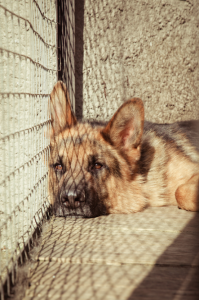 As dog lovers, we’re sometimes faced with a decision that can have a big impact on our life: getting a dog. Whether it’s our first dog or we’re replacing a dog that recently passed or we already have a dog or two and would like to add another one to our household, finding the right dog can be an exciting but treacherous adventure. Should we get a purebred dog or a mix? Should we go to a breeder or to the pound? How do I select the best puppy amongst others? Do temperament tests have any predictive value? Is there a best age to get a dog? In the best of worlds, a dog will be part of our family for close to 15 years so spending a little time up front can make the difference between a successful or a frustrating experience. Over the years, I’ve had more dogs in my house than I can count. Each one of them presented his/her own set of qualities and challenges. Let’s look at a few guidelines for getting a dog that I would recommend anyone to consider before adopting a new best friend.
As dog lovers, we’re sometimes faced with a decision that can have a big impact on our life: getting a dog. Whether it’s our first dog or we’re replacing a dog that recently passed or we already have a dog or two and would like to add another one to our household, finding the right dog can be an exciting but treacherous adventure. Should we get a purebred dog or a mix? Should we go to a breeder or to the pound? How do I select the best puppy amongst others? Do temperament tests have any predictive value? Is there a best age to get a dog? In the best of worlds, a dog will be part of our family for close to 15 years so spending a little time up front can make the difference between a successful or a frustrating experience. Over the years, I’ve had more dogs in my house than I can count. Each one of them presented his/her own set of qualities and challenges. Let’s look at a few guidelines for getting a dog that I would recommend anyone to consider before adopting a new best friend.
We’re all naturally drawn to certain types of dogs over others. Some love the bully breeds, others prefer the retrievers, the terriers or the shepherds. Personal taste plays a major factor in our choice for getting a dog. Let’s face it, many of us base the larger part of our choice of dog just on looks alone or emotional connection to the breed. But picking a dog based on breed or appearance can be the equivalent of getting married to a very attractive person who may empty our bank account, alienate us from our family and friends and complain and criticize us all day long. There’s a point where those good looks are simply not worth it. Our dream breed may very well not fit our lifestyle at all and turn out to be a destructive beast from boredom and anxiety. There are many websites that offer lots of great advice when it comes to picking the right breed. Always keep in mind that genetics does play an important role. A dog’s behavior is greatly influenced by his/her genetic predispositions as well as their interaction with the environment. So if we can’t stand barking, we shouldn’t get a beagle! But studies reveal that breed mostly defines physical traits. Beyond certain behavior characteristics, breed is not a reliable factor when it comes to predicting behavior (Bradley, 2011). Even Golden retrievers can develop aggression issues and certain border collies are very calm, even sluggish (I have one at home!). Another way to pick the best type of dog is to proceed by elimination and look at traits that would not fit our lifestyle or personality. Could we provide enough physical and mental stimulation to a very active dog? Is barking something that we appreciate or that we cannot tolerate (in which case a hamster may be a better choice)? How much shedding can we endure? Can we put up with strong prey drive? Do we like a Velcro dog, constantly following us around or snuggling up on our lap or would we be more comfortable with a more independent pooch?
Once we’ve identified the right type of dog for our lifestyle, the next question is where to get the dog: the rescues and shelters, a breeder, a neighbor or the pet store? Let’s look at the pros and cons to every one of these choices (listed here in order of preference).
A rescue group or shelter:
 This is my personal favorite for several reasons. Since all the dogs I train for service work come from shelters, I can attest that there are plenty of great dogs that are surrendered for no fault of their own. The majority of pets surrendered are between 5 months and 3 years of age and a quarter of those dogs are purebred. So if we’re looking for certain physical traits, there are plenty of beautiful dogs to pick from. That being said, studies also show that behavior issues are an important reason why dogs are surrendered by their guardians (Kogan & al, 2000), so here again it’s important apply some wisdom in our choices. Although there are puppies at the shelters, most will be older. This actually presents a major advantage. Puppies are cute and most are very social and fun but puppy hood is very short. It’s when they grow up and go through adolescence that most problems start. Dogs may develop reactivities and fears that weren’t necessarily there before. In addition to ethical considerations, adopting older dogs has benefits. What you see is what you get. In other words, a 2 year old dog is less likely to change from a behavioral stand point than a 3 month old puppy. Most dogs are already potty trained, have stopped chewing on everything and their behavior has become more predictable. Most rescues and shelters also provide guidance and help in choosing the right dog based on their assessment. Contrary to the store or breeder, their interest is in making the placement successful, not just on making a sale.
This is my personal favorite for several reasons. Since all the dogs I train for service work come from shelters, I can attest that there are plenty of great dogs that are surrendered for no fault of their own. The majority of pets surrendered are between 5 months and 3 years of age and a quarter of those dogs are purebred. So if we’re looking for certain physical traits, there are plenty of beautiful dogs to pick from. That being said, studies also show that behavior issues are an important reason why dogs are surrendered by their guardians (Kogan & al, 2000), so here again it’s important apply some wisdom in our choices. Although there are puppies at the shelters, most will be older. This actually presents a major advantage. Puppies are cute and most are very social and fun but puppy hood is very short. It’s when they grow up and go through adolescence that most problems start. Dogs may develop reactivities and fears that weren’t necessarily there before. In addition to ethical considerations, adopting older dogs has benefits. What you see is what you get. In other words, a 2 year old dog is less likely to change from a behavioral stand point than a 3 month old puppy. Most dogs are already potty trained, have stopped chewing on everything and their behavior has become more predictable. Most rescues and shelters also provide guidance and help in choosing the right dog based on their assessment. Contrary to the store or breeder, their interest is in making the placement successful, not just on making a sale.
A breeder
The value of getting a dog from a reputable breeder is the ability to be able to choose a dog with a certain genetic profile. This can be especially important if you’re looking for a dog with specific purposes (e.g.: working or sporting dogs). But just because dogs are of the same breed doesn’t mean they’ll behave in the same predictable way. within just a few generations innate predispositions for the work they were initially designed for can be lost (Coppinger, 2001). For example in Greyhounds only 70-80% of them will show prey drive, even though that behavior trait is heavily selected through breeding (Bradley, 2011). So in the end, breed alone is not enough to predict a dog’s potential behavior. There are many other factors to consider.
 Just like with any other profession, there are great and ethical breeders but also so-so or even terrible breeders. Just like good looks can be deceiving, a fancy website with professional pictures is not a good measure of the knowledge and practices of any given breeder. In fact, I have found some great breeders with very bad websites. The only way to assess a breeder is to go to their facility and check it out. In most cases, the best predictor for future behavior is in assessing the parents. So meeting the parents and asking many questions about their personality is critical. Other crucial factors have to do with where the puppies are raised and how much interactions they have with people. I have met fancy breeders with puppies raised in a large, clean and state of the art barn that turned out to be skittish due to insufficient stimulation and exposure to people or other stimuli. The ideal situation is to have puppies inside the house, where they can hear the phone, the TV, be around kids playing, adult dogs, etc. A knowledgeable breeder will provide puppies with things to climb on, different surfaces and different objects to explore. Puppies need to experience the world in a safe way at an early age in order to develop confidence, coping skills and social skills. If young kids live in the house it’s even better. Children will manipulate the puppies, play with them, touch them in awkward ways and expose them to their smells and sounds.
Just like with any other profession, there are great and ethical breeders but also so-so or even terrible breeders. Just like good looks can be deceiving, a fancy website with professional pictures is not a good measure of the knowledge and practices of any given breeder. In fact, I have found some great breeders with very bad websites. The only way to assess a breeder is to go to their facility and check it out. In most cases, the best predictor for future behavior is in assessing the parents. So meeting the parents and asking many questions about their personality is critical. Other crucial factors have to do with where the puppies are raised and how much interactions they have with people. I have met fancy breeders with puppies raised in a large, clean and state of the art barn that turned out to be skittish due to insufficient stimulation and exposure to people or other stimuli. The ideal situation is to have puppies inside the house, where they can hear the phone, the TV, be around kids playing, adult dogs, etc. A knowledgeable breeder will provide puppies with things to climb on, different surfaces and different objects to explore. Puppies need to experience the world in a safe way at an early age in order to develop confidence, coping skills and social skills. If young kids live in the house it’s even better. Children will manipulate the puppies, play with them, touch them in awkward ways and expose them to their smells and sounds.
A neighbor
The neighbor’s dog has puppies. They’re adorable, friendly and because you see them all the time, you’re growing more and more tempted to adopt one of them. Here again, if the puppy’s breed already matches what you’re looking for, the same considerations as above must apply. How are the parents, where and how the puppies are raised should be a critical part of the decision to adopt or not, not the convenience of a free puppy.
A pet store
This is the one place that I would never recommend. Besides medical concerns, there are a number of behavioral risks that come with puppies displayed in a pet store. There is no way to tell where the puppies come from. Do they come from a puppy mill or from a reputable breeder? Puppy mills never advertise as “mills” and have a number of ways to present themselves under the best light. Where were the puppies kept, a kennel with little stimulation or a rich environment? And what about the parents? Are they social and friendly or are they kept away from visitors? There are just too many unknowns and potential problems down the road.
 Temperament Tests
Temperament Tests
Whether we’re choosing a puppy amongst several siblings or trying to assess a dog in a shelter, the temperament tests available to this day only provide limited predictive value (Mornement & al, 2009). Does that mean we should simply disregard them altogether? Such behavioral measures still give us some idea of the dog’s potential. They can tell us how the dog is likely to behave in similar circumstances. Their results however should be considered within the context they were administered. Does the dog bark and lunge or on the contrary, cower and try to escape when scared? Is the dog looking for social contact more than he/she is exploring the environment? How does the dog react when you lean over or grab a paw? It’s important to keep in mind however that a confident looking puppy may be very fearful when taken to a different location. In the same way, an overly excited and pushy dog in a shelter can have very high cortisol levels due to the situation. The same dog may react very differently after a few weeks in a home environment. I’ve had dogs show resource guarding towards other dogs at first, but over the course of a week, they were happy to share their toys. Once their stress level came down, they became more confident, easy going and tolerant.
Here are a few other factors to consider:
- If you already have a dog, it’s best to avoid adopting a dog of the same sex, especially if that dog is a female. Most females get along just fine. In certain cases however, the competition between dogs grows so strong that one of them has to be re-homed. Getting dogs of opposite sex increases the chances of getting along long term.
- Do not get two dogs of the same litter. Siblings play and stick together. They’ll get most of their social needs met from one another which will limit how much they will bond with and respond to us.
- When picking a puppy from a litter, look for a balanced and well-adjusted pup. Stay away from the runt of the litter, the shy and fearful or from the bold puppy. Those puppies are more likely to be challenging as they grow older.
- Have a training plan in place before you bring the puppy or dog home. Where is it going to sleep, stay when left alone, go potty and most importantly, where will he/she get training and exposure. Consider the help of a professional dog trainer in choosing and training a dog.
Getting a new dog is exciting and fun. Dogs are truly fantastic companions but they can also become a burden if we misjudge their needs and our ability to provide to them. After the honeymoon period, when the novelty has worn out, we’re faced with the reality of our decision. In the end, a big part of selecting the right dog comes down to picking the right type of dog for our lifestyle and the right individual that we can manage. Overall, a large key to success lies in our understanding of our own desires and most of all, of our own limitations.
Jennifer Cattet Ph.D.





Thanks for this thorough and insightful post; I’d reckon it’s a must-read for first-time dog owners!
I just loved your “…equivalent of getting married to a very attractive person who may empty our bank account…”. So often, so true. A very nicely done guide.
On siblings, I’ve heard that for years, and some shelters require them to be adopted apart. But I’ve rarely seen those issues in practice. I have two foster siblings who play well together, but at the dog park they often go for different dogs to play with, even though they lived together for the first six months (as ferals) before coming here. Both have bonded with me, though somewhat differently. I’ll agree there may be a tendency, but perhaps no more than many others.
I have kept siblings without any trouble. The only real drawback is that they both age together. Ideally I would like to have five years between the ages of my dogs 😉 One old, one trained and at working age, and one to train 🙂
Basically, it is “don’t leave the dogs together to entertain each other”. I’ve heard people particularly choosing dogs of a similar age to ‘keep each other company’. Dogs do enjoy each other’s company, but like children they all need their own special time with their person/parent, or you get dogs/children who are unsocalised for human/adult company.
But as to CHOOSING a pup, the only fail-safe method I’ve found (after several grave mistakes 🙂 is to choose a puppy that snuggles in under your chin when you pick him/her up 🙂
(Well, that and to know your breed types. I DID make the grave mistake of ‘rescuing’ a “Kelpie” that turned out to be a terrier — probably Schnauzer/Jack Russell.. Nice dog for those as love terriers — didn’t fit in with Kelpies and German Shepherds 🙁
I love dogs. Well actually this post has a lot of helpful information. Well, in my own experience I didn’t follow that there are also steps in choosing a dog. Actually it also have to do with the type of personality of the owner. I believed, choosing our own dog, will also reflect on what king of personality we have.